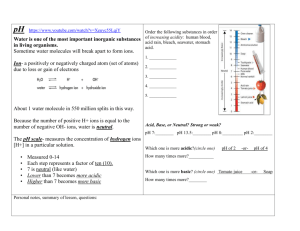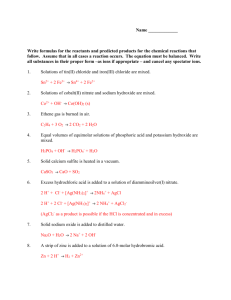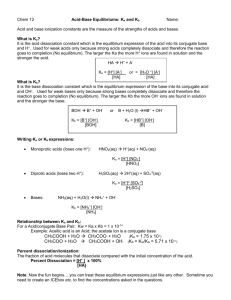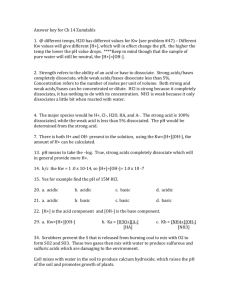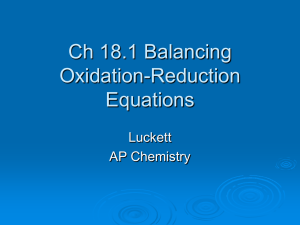doc
advertisement
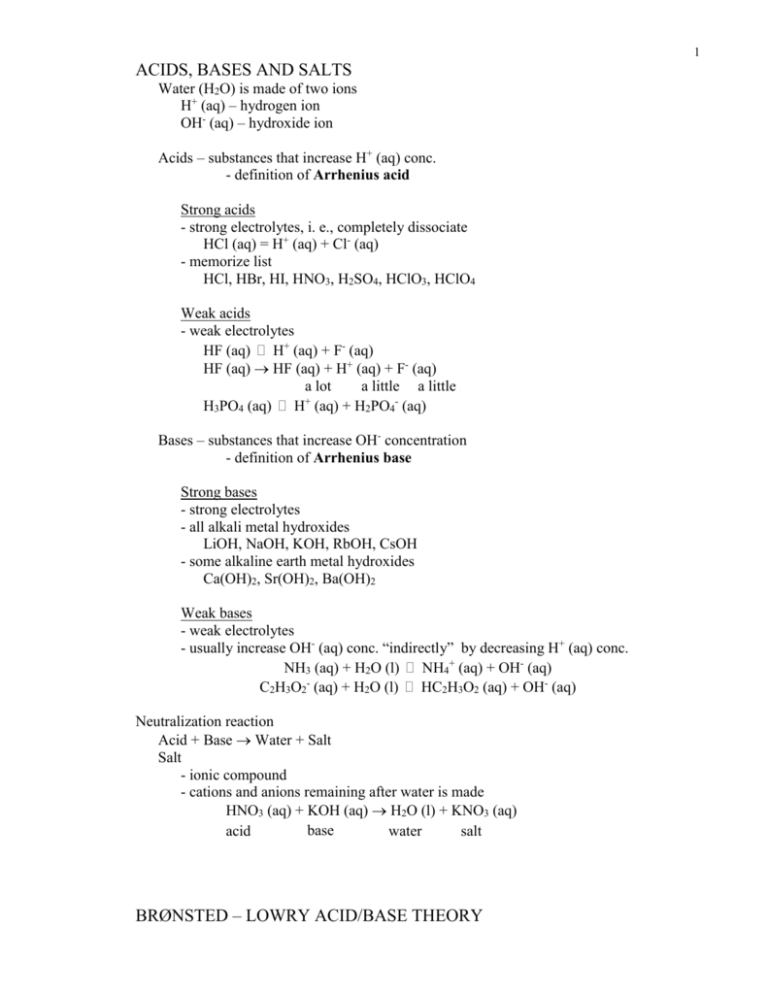
1 ACIDS, BASES AND SALTS Water (H2O) is made of two ions H+ (aq) – hydrogen ion OH- (aq) – hydroxide ion Acids – substances that increase H+ (aq) conc. - definition of Arrhenius acid Strong acids - strong electrolytes, i. e., completely dissociate HCl (aq) = H+ (aq) + Cl- (aq) - memorize list HCl, HBr, HI, HNO3, H2SO4, HClO3, HClO4 Weak acids - weak electrolytes HF (aq) H+ (aq) + F- (aq) HF (aq) HF (aq) + H+ (aq) + F- (aq) a lot a little a little + H3PO4 (aq) H (aq) + H2PO4- (aq) Bases – substances that increase OH- concentration - definition of Arrhenius base Strong bases - strong electrolytes - all alkali metal hydroxides LiOH, NaOH, KOH, RbOH, CsOH - some alkaline earth metal hydroxides Ca(OH)2, Sr(OH)2, Ba(OH)2 Weak bases - weak electrolytes - usually increase OH- (aq) conc. “indirectly” by decreasing H+ (aq) conc. NH3 (aq) + H2O (l) NH4+ (aq) + OH- (aq) C2H3O2- (aq) + H2O (l) HC2H3O2 (aq) + OH- (aq) Neutralization reaction Acid + Base Water + Salt Salt - ionic compound - cations and anions remaining after water is made HNO3 (aq) + KOH (aq) H2O (l) + KNO3 (aq) base acid water salt BRØNSTED – LOWRY ACID/BASE THEORY 2 Acid/base reactions are simply transfer of proton (hydronium ion) from acid to base. Brønsted – Lowry Acid - proton donor - note HCl, H2SO4, HC2H3O2 all donate protons Brønsted – Lowry Base - proton acceptor - note OH- and NH3 accept protons In Brønsted – Lowry theory, water is an acid or base depending on the circumstances. HCl (aq) + H2O (l) H3O+ (aq) + Cl- (aq) - water accepts proton; therefore, it is a base. NH3 (aq) + H2O (l) NH4+ (aq) + OH- (aq) - water donates proton; therefore, it is a acid. Conjugate Acids and Bases Consider a typical acid/base reaction. NH3 (aq) + H2O (l) NH4+ (aq) + OH- (aq) - H2O has donated proton, it is an acid. - NH3 accepted proton, it is a base. Consider the reverse reaction. NH4+ (aq) + OH- (aq) NH3 (aq) + H2O (l) - NH4+ has donated proton, it is an acid. - OH- accepted proton, it is a base. - An acid is changed into a base and a base is changed into an acid. - These pairs of acids and bases are called conjugate acid-base pairs. - A conjugate acid-base pair differ from each other only by a proton. NH3 (aq) + H2O (l) NH4+ (aq) + OH- (aq) Another Example: H2SO4 (aq) + H2O (l) HSO4- (aq) + H3O+ (aq) Another Example: 3 HC2H3O2 + NaOH H2O + NaC2H3O2 acid base conjugate conjugate acid base Relative strengths of acids and bases The strength of a conjugate base is related to the strength of its acid. The strength of a conjugate acid is related to the strength of its base. Consider perchloric acid: HClO4 (aq) – acid ClO4- (aq) – conjugate base HClO4 is a very strong acid, meaning that it fully dissociates. HClO4 (aq) H+ (aq) + ClO4- (aq) - This means that the ClO4- ion has no desire to accept a proton. - Therefore the perchlorate ion is a very weak (negligible) base. Consider aqueous sodium hydroxide: OH- – base H2O – acid NaOH (aq) Na+ (aq) + OH- (aq) - OH- ion reacts fully (almost) with H+ ions. - If any additional H+ is added, OH- will grab it to form water. - OH- is a very strong base. - The conjugate acid, H2O is a very weak acid. As the strength of acid increases, the strength of its conjugate base decreases. As the strength of base increases, the strength of its conjugate acid decreases. Example: HC2H3O2 is a weaker acid than HF. Which ion will more readily accept protons in aqueous solution, C2H3O2- or F-? HC2H3O2 is weaker acid; therefore, C2H3O2- is stronger base. Thus C2H3O2- will accept a proton more readily. Example: Pyridine, C5H5N, is a weaker base than ammonia, NH3. Which ion is the stronger acid, NH4+, C5H5NH+? C5H5N is weaker base; therefore, C5H5NH+ is stronger acid. Therefore, C5H5NH+ will donate its proton easier that NH4+. Pyridine is a base used in methods that determine the moisture content of foods. THE AUTOIONIZATION OF WATER - Water is not a nonelectrolyte, actually it is a very weak electrolyte. 4 - One out of every 10 million water molecules dissociates into an H+ ion and a OH- ion. H2O (l) H+ (aq) + OH- (aq) Ion product of water Write equilibrium expression H OH Kc H O 2 - Since H2O is solvent, we will neglect it in equilibrium expression. No matter what conditions exist in an aqueous solution, the following expression is true. (at 25 C) H OH 1.0 1014 Ion product is also known as Kw. K w H OH 1.0 1014 Aside: Other solvents autoionize as well. NH3 + NH3 NH4+ + NH2CH3OH + CH3OH CH3OH2+ + CH3OSince H OH 1.0 1014 is always true - if we know [H+], we can calculate [OH-] - if we know [OH-], we can calculate [H+] Example: If a solution has [H+] = 1.8 x 10-5 M, what is [OH-]? Example: If a solution has [OH-] = 9.4 x 10-12 M, what is [H+]? Example: What is the [H+] and [OH-] for pure water? H2O(l) H+ (aq) + OH- (aq) Kw H 5 OH [H+] 0 x x Initial Change Equil. x 2 1.0 1014 [OH-] 0 x x x 2 x 1.0 107 H 1.0 107 M OH 1.0 107 M Note: When [H+] = [OH-], the amount of acid and base are in equal amounts. The solution is called neutral. THE HYDRONIUM ION H+ is simply a proton. - A proton will hydrogen bond with water H H H H O O + H+ H H3O+ is a hydronium ion. Current theories of water treat proton as surrounded by 4 or 6 water molecules. Therefore, H+ may be truly H9O4+ or H13O6+. H H O H H H+ O O H H O H H H3O+ is a concept, not an actual structure. Reconsider autoionization of water as H2O (l) + H2O (l) H3O+ (aq) + OH- (aq) pH SCALE Definition: pH = - log [H+] = -log[H3O+] pH scale is used strictly for convenience 6 - convenient to avoid scientific notation. [H+] for pure water equals 10-7; therefore, pH = - log(10-7) = - (-7) = 7 All neutral solutions have pH = 7. If solution is acidic, pH < 7. If solution is basic, pH > 7. pH scale of common substances very acidic slightly acidic neutral 1 2 3 4 5 6 7 gastric acid lemon juice coke slightly basic coffee very basic 8 9 10 11 12 13 milk of magnesia household ammonia household bleach blood **In a number that is a logarithm such pH, only the digits to the right of decimal point are significant.** [H+] = 5.38 10-2 pH = 1.269 [H+] = 5.38 10-5 pH = 4.269 [H+] = 5.38 10-8 pH = 7.269 [H+] = 5.38 10-12 pH = 11.269 Other definitions: pOH = - log [OH-] pKw = - log Kw = 14.00 Autoionization of water in terms of pH - log([H+][OH-]) = -log Kw pH + pOH = pKw = 14.00 Example: The pH of milk of magnesia is 10.0, what is the pOH? pOH = pKw – pH = 14.00 – 10.0 = 4.0 Example: An sodium cyanide solution used to extract gold from low-grade ore has a pH of 10.67, what is the hydronium ion concentration of the solution? 4 Au (s) + 8 CN- (aq) + O2 (aq) + H2O (l) 4 Au(CN)2- + 4 OH- (aq) Example: A basic solution of trisodium phosphate (TSP), Na3PO4, from the hardware store has a pOH of 2.14, what is its hydroxide ion concentration? 7 You know that the proper name for TSP is sodium phosphate! STRONG ACIDS AND BASES Remember lists Strong Acids: HCl, HBr, HI, HNO3, H2SO4, HClO3, HClO4 Strong Bases: Alkali metal hydroxides, Ba(OH)2, Sr(OH)2, Ca(OH)2, Mg(OH)2 limited solubility Calculating pH of strong acid and strong base solutions Strong acids and bases completely dissociate; therefore, [H+] (or [OH-]) equals the concentration of the solute. Example: What is the pH of a 0.0142 M solution of HBr? Since HBr is a strong acid, [H+] = 0.0142 M pH = - log (0.0142) = - (-1.848) = 1.848 Example: What the pH of 1.5 M Sr(OH)2 solution? Since Sr(OH)2 is a strong base, OH 1.5molSr(OH)2 L 2 molOH 1molSr(OH)2 3.0 M 1.0 1014 1.0 1014 H 3.3 1015 M 3.0 OH pH = - log (3.3 10-15) = 14.48 OR pOH = - log (3.0) = -0.48 pH = 14.00 – pOH = 14.00 – (-0.48) = 14.48 WEAK ACIDS AND BASES For weak acids and bases, the concentration of acid (base) is not the concentration of [H+] ([OH-]). 8 Weak Acids Dissociated ions are in equilibrium with undissociated molecule. HC2H3O2 (aq) H+ (aq) + C2H3O2- (aq) Equilibrium expression is H C H O Ka 2 3 2 HC H O 2 3 2 Ka – acid-dissociation constant - only difference from Kc is the label. Each weak acid has its own Ka which does not change (at 25 C). Example: What is the pH of 2.0 M ascorbic acid (HC6H7O6), also known as vitamin C? Ka (HC6H7O6) = 8.0 10-5. Vitamin C is necessary for the production of collagen, a fibrous protein that is found in skin, tendon, blood vessels, organs, bone. Citrus fruit contains a substantial amount of vitamin C. Example: What is the pH of 0.15 M iodic acid (HIO3)? Ka (HIO3) = 0.17. 9 Assume that x is small. x2 017 . 015 . x2 015 . 017 . 0.026 x = 0.16 Hmmm! Looks like x is not small. We will need the quadratic equation. x2 Ka 017 . 015 . x x2 017 . 015 . x 0.026 017 . x x2 017 . x 0.026 0 b b 2 4ac 0.17 x 2a 0.17 2 4 1 0.026 2 1 0.17 0.1329 0.17 0.36 0.097 2 2 x = [H+] = 0.097 pH = 1.01 Iodic acid is used in the production of sodium iodate and potassium iodate. Both iodate compounds are added to table salt to “iodize” the salt. Iodine is necessary for healthy thyroid function. Example: Calculate the pKa of an unknown acid solution with a concentration of 0.0988 M and a pH of 4.43. 10 Polyprotic Acids - Many acids have more than one proton to donate. Consider H2SO4 H2SO4 is a strong acid. H2SO4 (aq) H+ (aq) + HSO4- (aq) Bisulfate ion also has a proton to donate, though it is less willing to do so. HSO4- (aq) H+ (aq) + SO42- (aq) H SO 12. 10 HSO 2 Ka 4 2 Ka 2 4 2nd proton disassociated Consider H3PO4 Phosphoric acid has 3 protons to donate - before second proton leaves, almost all of the first protons have left. H H PO 7.5 10 H PO H HPO 6.2 10 H PO H PO 4.2 10 HPO K a1 2 3 4 4 2 Ka 2 4 8 2 4 3 Ka 3 3 4 13 2 4 When we add H3PO4 to water, the disassociation is H3PO4 (aq) H+ (aq) + H2PO4- (aq) How can we get the second proton to leave? - Remove H+; i.e., add base. H2PO4- (aq) H+ (aq) + HPO42- (aq) 11 Weak Bases Conc. of OH- is not concentration of weak base. Consider ammonia NH3 (aq) + H2O (l) NH4+ (aq) + OH- (aq) Equilibrium expression is NH OH NH Kb 4 3 Kb – base-dissociation constant - only difference from Kc is the label. Consider general base B (aq) + H2O (l) BH+ (aq) + OH- (aq) Equilibrium expression is BH OH Kb B Example: Calculate the OH- concentration of 0.012 M solution of pyridine, C5H5N. Kb(C5H5N) is 1.7 10-9. H N C H C + C H H2O C C H Assume that x is small. H H+ N H H H C C C C C H + H OH- 12 Example: Calculate the pH of 3.4 M solution of soda ash, otherwise known as sodium carbonate, Na2CO3. Kb(CO32-) = 1.8 10-4 When Na2CO3 is dissolved in water, it is fully disassociated. (All sodium salts are soluble.) Na2CO3 (aq) = 2 Na+ (aq) + CO32- (aq) Consider that CO32- is the conjugate base of HCO3-. Assume that x is small. x2 18 . 104 x2 34 . 18 . 104 61 . 104 3.4 x = [OH-] = 2.510-2 M pOH = 1.60 pH = 12.40 Check assumption: 0.025 100% 0.74% 0.74% 5% 3.4 Also 3.4 – 0.025 = 3.375 3.4 Assumption is good. Soda ash is combined with calcium carbonate and sand (SiO 2) to make soda lime glass, the type of glass most commonly used in bottles and windows. Percent Ionization (Degree of Ionization) While the dissociation constant gives a measure of the strength of a weak acid or base, it doesn’t give any indication of how much electrolyte actually dissociates. By definition, the percent ionization is the percentage of weak electrolyte molecules that have dissociated in solution 13 For a weak acid, the percent ionization is H electrolytedissociated % ionization 100% 100% or electrolyteinitial HA0 A 100% . HA0 Note the ambiguity in the definition. - For pure weak acid, either definition is valid. - If extra A- is added, use [H+] definition. - If extra H+ is added, use [A-] definition. - If in doubt, smaller number is correct. For a weak base, the percent ionization is OH electrolytedissociated % ionization 100% 100% electrolyteinitial B0 or HB 100% . B0 - For pure weak base, either definition is valid. - If extra HB+ is added, use [OH-] definition. - If extra OH- is added, use [BH+] definition. - If in doubt, smaller number is correct. Example: Calculate the percent ionization of hydrofluoric acid in a 1.0 M, 0.10 M and 0.010 M solutions. Ka(HF) = 6.8 10-4 To calculate percent ionization, we need [H+], therefore, we need an ICE table. H F K a 6.8 104 HF For a variable initial concentration c Initial Change Equil. [H+] 0 x x [F-] 0 x x [HF] cM –x c–x x2 Ka 6.8 104 c x Assume that x is small. x2 6.8 104 c x 2 c 6.8 104 x c 6.8 104 [H ] 14 x % ionization 100% c For c = 1.0 M, x 1.0 6.8 104 0.026 % ionization 0.026 100% 2.6% 1.0 For c = 0.10 M, x 0.10 6.8 104 0.0082 0.0082 100% 8.2% 0.10 Oops! Now x is not small! Ka x2 c x x2 Ka c x x 2 Ka x Kac 0 2 b b 2 4ac K a K a 4 1 K a c x 2a 2 1 6.8 104 6.8 10 4 2 2 4 6.8 10 2.7 10 2 0.0079 4 1 6.8 10 4 0.10 c = [HF]0 1.0 0.10 0.010 4 [H+] 0.026 0.0079 0.0023 6.8 10 4 1.7 10 2 2 % ionized 2.6 7.9 23 pH 1.58 2.10 2.64 Note that as the concentration of weak acid decreases, more of it dissociates! Artists use hydrofluoric acid to etch glass. Relationship between Ka and Kb Consider Kb of ammonia. Kb(NH3) = 1.8 10-5 NH3 (aq) + H2O (l) NH4+ (aq) + OH- (aq) NH 4 OH Kb NH 3 15 Now consider Ka of conjugate acid, NH4+ NH4+ (aq) + H2O (l) NH3 (aq) + H3O+ (aq) H 3O NH 3 Ka NH 4 Now multiply Ka and Kb. NH H O NH OH H O OH NH NH Ka Kb 3 3 4 4 Thus for a conjugate acid-base pair: 3 3 Ka Kb = Kw Example: If Kb(NH3) = 1.8 10-5, what is Ka for NH4+? Example: If Ka(HF) = 6.8 10-4, what is Kb for F-? Ka Kb = Kw also implies pKa + pKb = 14.00 HYDROLYSIS Many salts when dissolved in water will change its pH. - Cations may attract the hydroxide ion. - Anions may attract the hydrogen ion. The process where ions cause water to split apart is called hydrolysis. 16 The acidic or basic properties of a salt solution depend on the relative abilities of the cation and the anion to cause hydrolysis. Cations are acidic (usually) 1. Cations from strong bases have negligible acidity. - Li+, Na+, K+, Rb+, Cs+, Ca2+, Sr2+, Ba2+ 2. Higher cationic charge causes greater hydrolysis. - Higher charges attract OH- more effectively. - pH of TlCl soln. higher than PbCl2 soln. Pb(H2O)62+ Pb(H2O)5(OH)+ + H+ 3. Smaller cations are more acidic than larger cations. - Higher charge density attracts OH- more effectively. - pH of Ga(NO3)3 sol. higher than Al(NO3)3 sol. 4. Transition metal ions are more acidic than alkali or alkaline earth metal ions. - Incomplete d subshell attracts OH- and H2O. - Co(ClO3)2 more acidic than Mg(ClO3)2. Co(H2O)62+ Co(H2O)5(OH-)+ + H+ 5. Conjugate acids of nitrogen bases are acidic. - NH4+, C5H5NH+, (CH3)3NH+, etc… NH4I (aq) + H2O (l) NH3 (aq) + H3O+ (aq) + I- (aq) Anions are basic 1. Anions from strong acids are not basic. - Cl-, Br-, I-, NO3- HSO4-, ClO3-, ClO42. Other soluble monatomic anions are basic. - K2S, Cs2O, BeH2 solutions are basic. S2- + H2O HS- + OHO2- + H2O OH- + OHH- + H2O H2 + OH3. Conjugate bases of weak acids are basic. - Al(C2H3O2)3, SrF2, Li2C2O4 are basic salts. F- + H2O HF + OH- Note: This is the dissociation of a weak base. Examples: Predict whether the following salt solutions are acidic, basic or neutral. a) KClO2 The K+ comes from a strong base; therefore, it should not affect the pH (it doesn’t attract OH- to itself). ClO2- comes from a weak acid; therefore, it should raise the pH (it attracts H+ a little). 17 b) Ni(NO3)2 The Ni2+ will attract OH-; therefore, it has the tendency to make the solution acidic. The NO3- comes from a strong acid; therefore, it won’t affect the pH. c) SrBr2 Sr2+ – neutral Br- – neutral Salts derived from weak acid and weak base may be acidic or basic - Both cation and anion hydrolyze water. - pH depends on which ion has stronger acid/base properties. - if base is stronger; i.e., Kb > Ka then pH > 7. - if acid is stronger; i.e., Ka > Kb then pH < 7. Example: Is a NH4NO2 solution acidic, basic or neutral? K a NH 4 K b NO2 Kw 1.00 1014 5.6 1010 K b NH 3 1.8 105 Kw Ka HNO2 100 . 1014 2.2 1011 4.5 10 4 Ka > Kb, thus pH < 7. NH4NO2 solution is acidic. Sodium nitrite is used in some meats as a preservative and to prevent the color of meat changing from red to brown. CHEMICAL STRUCTURE OF ACIDS AND BASES Basic Principles of Acidity 1. Acidity is related to bond strength. - H2Se is more acidic than H2S because the H – Se bond is weaker than the H – S bond (Se is larger than S; therefore the bond overlap for the H – Se bond is weaker than for the H – S bond). 2. Acidic hydrogens ionize from a polar bond. 18 3. Polarity of the acidic hydrogen bond can be affected to a lesser extent by other atoms. 4. Strong attraction of the water (solvent) molecules is the driving force. Binary Acids - Bonds between water molecules and ions are stronger than bonds between acid molecules. H O H O H H Cl H H H + H Cl H These bonds are stronger than these bonds. O O H H Cl Consider HF - Bonds between HF molecules are very strong. - HF (aq) + HF (aq) [F – H – F]- (aq) + H+ (aq) H+ H These bonds are stronger than these bonds. O H O H H F- - Even though HF is very polar, it is a weak acid since it forms strong intermolecular bonds with itself. HF etches glass (and bone!). It cannot be stored in a glass bottle. Oxyacids - Oxyacids are essentially molecular compounds. - Bonds holding H+ must be strongly polar to allow H+ to disassociate. - Must be considerable difference in electronegativity to create polar bond. O O Cl O H O polar bond 19 - Secondary effects are very important. - Electron withdrawing of other oxygen atoms is the difference between HClO4 being a strong acid rather than a weak acid. Compare to HClO2. O Cl O H bond is less polar since fewer oxygen atoms are drawing away electron density Example: Which is the stronger acid, acetic acid or trichloroacetic acid? H O H C Cl O C O H Cl C C O H H acetic acid Cl trichloroacetic acid Chlorine atoms are much more electronegative that hydrogen atom Chlorine atoms are much more electronegative that hydrogen atoms; therefore, the chlorine atoms are making the O – H bond more polar thus increasing the acidity. Trichloroacetic acid is used in some tattoo removal processes. LEWIS ACIDS AND BASES Definitions Lewis acid – electron pair acceptor Lewis base – electron pair donor Lewis acid/base theory is more general than Brønsted – Lowry acid/base theory. - Brønsted – Lowry acids are Lewis acids, though not vice versa. - Brønsted – Lowry bases are Lewis bases, though not vice versa. Consider H3O+ (aq) + OH- (aq) H2O (l) 20 H O H H O H H O H O H H + H is electron pair acceptor - Lewis acid OH- is electron pair donor - Lewis base Consider NH3 (aq) + H2O (l) NH4+ (aq) + OH- (aq) H H N H H H O H H N H H O H - NH3 is electron pair donor - H2O is electron pair acceptor Not all Lewis acid/base reactions are Brønsted-Lowry acid/base reactions. Lewis acid – accepts e- pair from Cl- Lewis base – donates e- pair via Cl- ion AlCl3 + CH3Cl AlCl4- + CH3+ other products This is the first step in the “Friedel-Crafts alkylation” that adds a methyl group to an organic molecule. More next year!

